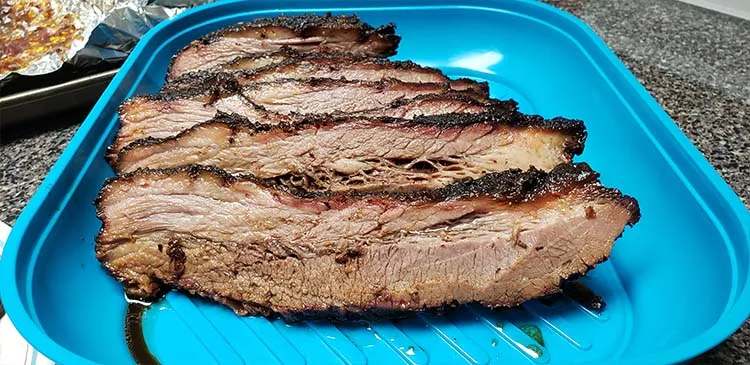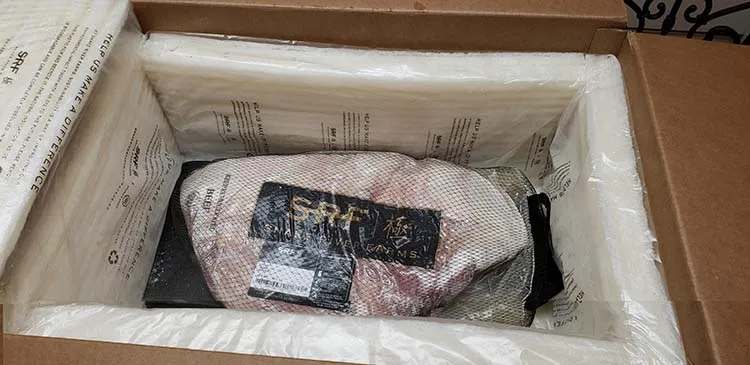The number one challenge when you cook a brisket is keeping the meat from drying out.
Moisture comes from the intramuscular fat or marbling which breaks down over a long cook.
Wagyu brisket is popular on the competition bbq circuit where pitmasters are looking for any edge they can get.
In this article, we’ll be breaking down what Wagyu means, how it differs from your standard brisket, where to get it, and how best to cook it.
What is Wagyu brisket?
The marbling found in Wagyu brisket helps to keep the leaner flat of the Brisket from drying out, adds to the melt-in-the-mouth texture, and renders down into delicious liquefied collagen.
But what exactly is Wagyu?
Wagyu, at its most basic, is just a combination of two Japanese words meaning “Japanese Cow.” In Japan, it is used to refer to one of four Japanese breeds of cattle.
Outside of Japan, the term almost exclusively refers to beef taken from the Kuroge Washu, or Japanese Black, breed of cattle.
The Kuroge Washu is prized across the globe for the intense marbling of its meat, which gives it a rich umami flavor and smooth buttery texture.
Most of the wagyu brisket you see for sale is actually American or domestic Wagyu.
If you want to try cooking Wagyu brisket we recommend the American Wagyu from Snake River Farms.
Japanese Wagyu vs. American Wagyu
One of the first things to understand about Wagyu beef is that there is a significant difference between Japanese and America Wagyu.
Japanese Wagyu only comes from 100% pure strains of Japanese cattle which are so carefully bred to maintain that purity that 99.9% of all Japanese Wagyu breeding cows can trace their lineage to just one bull.

Domestic or America Wagyu traces its lineage back to full blood Kuroge Washu cattle exported from Japan during the 1980s. These cattle ended up in Canada, Australia, and the US where they were interbred with Angus strains to increase the yield.
The USDA does certify American Wagyu beef but, unlike Japanese Wagyu, the meat only has to contain 46.875% pure Kuroge Washu blood to qualify.
Generally, Japanese Wagyu is the more premium product. It’s better quality but difficult to source and very expensive.
American Wagyu is still excellent quality beef, almost always graded as Prime on the USDA grading scale, but it is most likely going to be a mix of Kuroge Washu and another breed.
Is Wagyu brisket, “worth it?”
Asking if any piece of meat is “worth it” is always a subjective question.
Wagyu brisket has the double advantage of being fantastic quality beef and having that extra marbling to counteract some of the drying issues commonly encountered when cooking brisket.

Wagyu brisket has also been trotted out as a secret weapon by 4-time World Barbecue Champion, Myron Mixon.
While Myron swears by it, not every famous pitmaster uses Wagyu brisket. Aaron Franklin prefers to use prime brisket and claims Wagyu has a less “beefy” flavor.
In our opinion, you should stick with cheaper brisket when you are learning and then splurge on Wagyu for special occasions.
What’s the difference between Wagyu and Prime Brisket?
There’s a common misconception that Wagyu is a higher grade of beef.
One of the main differences between Wagyu Brisket and USDA Prime Brisket is the grading system used to certify them.
The USDA grades less than 2% of all beef produced in the US as Prime. That certification comes from an examination of two factors: the age of the carcass at the time of slaughter, and intramuscular fat content.
These factors are determined by examining the meat of the ribeye taken from between the 12th and 13th ribs.
Wagyu beef is most commonly graded using the Japanese beef grading system. This more complicated certifications system uses three separate grades:
- Yield Grade is a letter grade that indicates how much meat can be taken from the most sought-after parts of the carcass. A means above average, B is average, and C indicates below average.
- Quality Grade examines the beef’s marbling, as the USDA grading system does, but also looks at the color and texture of the meat and the quality of the fat. Based on those four factors, the meat is scored between 1 (lowest quality) and 5 (best quality).
- Beef Marbling Score (BMS) looks at the meat’s marbling in more detail, giving it a number grade that runs from 1 (little or no marbling) to 12 (extreme marbling).
The best Japanese Wagyu is graded A1 9-12. This means the meat is of the best quality, the yield from the most popular sections of the carcass is above average, and the marbling is “extreme.”
We have a full guide where you can read more about how beef is graded around the world.
Generally, Wagyu beef providers will use the full Japanese beef grading system for imported Wagyu brisket and a combination of the USDA grading system and a BMS score for American Wagyu Brisket.
Wagyu vs. Prime
In many ways, a Wagyu Brisket with a BMS of 9 and above is a step up from a standard USDA Prime Brisket.
The meat might be of similar quality, but the Wagyu brisket will have a much greater abundance of marbling and a better quality of intramuscular fat, which adds to its flavor and texture.
A5 graded authentic Japanese Wagyu Brisket is some of the best beef in the world, but with a price of around $1440 for a 32lbs chunk, it’s a little pricey for anything other than competition cooking.
Where to buy Wagyu Brisket
Snake River Farms
First founded in 1968, this family-owned business has transformed from a ranching and feeding operation into a premier supplier of top-quality beef and pork to both Michelin-star restaurants and everyday pitmasters.
Snake River takes its meat very seriously, carefully managing the life-cycle of their cattle and using traditional Japanese feeding methods to get their cross-bred Angus/Wagyu cattle as close to their Japanese ancestors as possible.

Snake River Farms offers two grades of Wagyu Brisket: Black Grade, which we had the pleasure of reviewing, and the premium Gold Grade, which has a BMS of 9+.
The meat is shipped frozen, rather than fresh, but that doesn’t seem to affect the taste. If you make your order by 1 pm EST, you’ll have it shipped to you via courier the very same day.
DeBragga
DeBragga offers a wide range of Wagyu beef, from ground beef and burgers to ultra-rare, Japanese culinary Olympics winning, Miyazaki-Gyu beef.
Their range of American Wagyu comes from Imperial Wagyu Beef and is a mix of Wagyu and Angus breeds.
DeBragga offers a two-pack of American Wagyu Brisket, at around 5-6 lbs each, for the very reasonable price of $225.
If you live in the Northwest, you can get these delicious Wagyu Briskets delivered fresh using overnight delivery. The only downside is that, if you don’t live in the Northwest, DeBragga commitment to shipping fresh meat can make delivery a little pricey.
How to cook a Wagyu Brisket
If you’ve smoked a regular brisket low and slow there’s no major difference when smoking a Wagyu brisket.
Here are a few suggestions to get the most out of the it:
- Leave a little extra time – The selling point of a Wagyu Brisket is the sheer amount of fat fleck marbling in the meat. This does mean, however, that it is going to take a little longer to render all that fat down. You might also need to boost the finishing temperatures up to as high as 213 to 217°F in order to really get that fat rendered down.
- Do a little extra trimming – Because of the extreme amount of intramuscular fat found in Wagyu beef, you can afford to be a bit more aggressive when you’re trimming your brisket. Anything over 1/4″ of fat and you run the risk of your Brisket becoming too fatty.
- Use a medium coating of rub – Wagyu is famous for its rich umami flavor. Using a medium coating of rub means you’ll still be able to appreciate those flavors, instead of hiding them under a blanket of herbs and spices.
- Use a meat probe – Cooking an expensive Wagyu brisket can be a nerve-wracking experience, so your meat thermometer is going to be your best friend. Keep your temperature stable, remember to check both ends of your Brisket and, if this is your first time cooking a brisket don’t be afraid of the temperature stall.
Wrapping it up
Wagyu brisket is a little divisive.
Some, including people who have won the World Barbecue Championship several times, think its the best brisket you can buy
Others prefer to stick to their tried and tested USDA Prime.
The best way to build your own opinion is to try it for yourself and, now you know how it’s graded, where to buy it from, and how best to cook it, you’ve got all the tools you need to cook up your own beautifully marbled Wagyu brisket.
After all, the proof is in the eating!